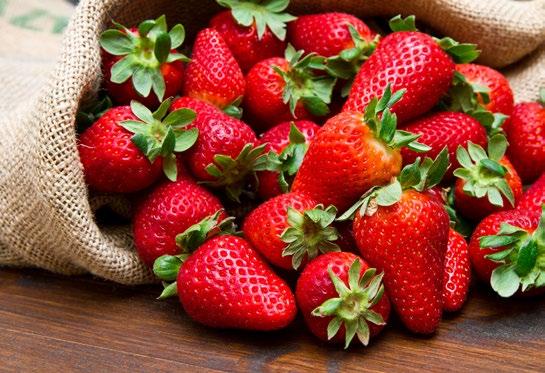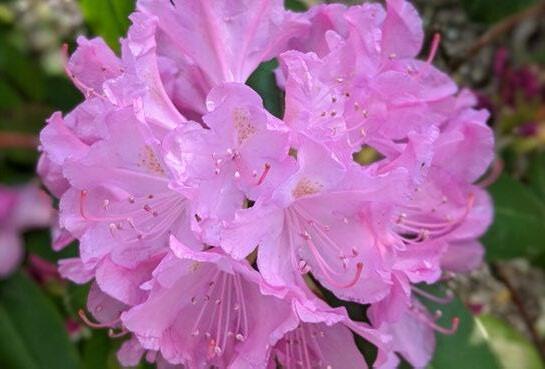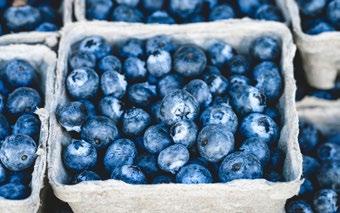
10 minute read
New report Provides Action Plan for Growing the Organic Seed Supply
BY FLORENTINA RODRIGUEz
State of Organic Seed (SOS) is an ongoing project to monitor organic seed systems in the U.S. Every five years, Organic Seed Alliance (OSA) releases this progress report and action plan for increasing the organic seed supply while fostering seed grower networks and policies that aim to decentralize power and ownership in seed systems.
More than ever, organic seed is viewed as the foundation of organic integrity and an essential component to furthering the principles underpinning the organic movement. OSA views organic agriculture as more than a package of production practices, but as a necessary social movement that can create a sustainable and equitable path for our seed, food, and farming systems.
WHY ORGANIC SEED?
The organic seed supply has grown tremendously since the National Organic Program (NOP) was established in 2002, which formalized the US organic standards. Certified organic growers are required to source organic seed when commercially available. Beyond helping growers meet a regulatory requirement, OSA views organic seed as an important catalyst for change in areas of ecological crisis, human and environmental health, and unbalanced power structures. The benefits of expanding organic seed in the field and marketplace include:
HUMATES
Gallons: 5, 15, 55, or 265 Dry super sacks: 2400 lbs. Or 50% semi-soluable (Magna Plus) OMRI certi ed Other dry water-soluable: 7-6-4 or 16-0-0
Frommelt Ag
• Seeds are alive and adapt to changing climates through seed saving, selection, and other classical plant-breeding techniques. This adaptation is key for a crop’s survival—mitigating risks for growers and the communities they feed. Organic plant breeding and organic seed are therefore key elements of adaptable and resilient farming systems. When these seeds are grown organically, the climate benefits are even greater. • Organic seed provides other environmental and human health benefits as well. Organic seeds are grown without synthetic chemicals and are not treated with synthetic chemical seed coatings, so growers who plant organic seed are choosing to keep pollution caused by synthetic pesticides out of our soils, water, air, and food. • We also believe that a healthy seed system is decentralized, with many decision makers at the table: seed growers/savers, plant breeders, farmers, consumers, chefs, food and seed businesses, Indigenous seed keepers and tribal nations, and others. In important ways, the expansion of organic seed systems has embraced decentralized approaches to plant breeding, seed production, and distribution. And as a social movement, we believe that organic seed can take a distinct path from the dominant conventional seed industry, where consolidation and privatization are key strategies.
REVIEWING THE DATA
This 2022 report is our third update, allowing us to compare new data with our 2011 and 2016 findings. The data comparisons included in this report provide a snapshot of progress (or lack thereof) and ongoing challenges and needs for expanding organic seed systems and the seed supply they support. Unfortunately, our newest findings show no meaningful improvement in organic seed usage since our first report.
We arrived at this and other conclusions through numerous data collection methods. SOS is drawn from seven data sets: four different surveys of organic growers, certifiers, researchers, and seed producers/companies; seed producer interviews; a database of organic research project funding; and grower focus groups organized by Organic Farming Research Foundation (OFRF).
kEY FINDINGS
As mentioned, the organic standards require sourcing of organic seed when commercially available, but most organic producers are still using non-organic seed for at least part (if not all) of their operations. Some key findings include:
ORGANIC pRODUCERS AND THEIR ORGANIC SEED USE
Vegetable producers who grow fewer than 50 acres of crops report using more organic seed. Much like we saw in our last report, the biggest vegetable producers still use relatively little organic seed, and this has a big impact on overall acres planted to organic seed.
Organic seed sourcing in field crops, forage crops, and cover crops remains stagnant. Approximately one-third of these growers report increasing the percentage of the organic seed they’re planting, and roughly 40 percent of producers report using about the same amount of organic seed compared to three years ago.
Producers report variety unavailability as their top reason for not sourcing organic seed. Furthermore, certifiers have a hard time identifying what might be substituted as an equivalent variety per the organic seed regulation.
We saw an increase in organic producers reporting a processor/buyer requirement as a factor in not sourcing organic seed. This finding was especially true among larger vegetable producers, and some certifiers also report these processor/buyer requirements as barriers to organic seed sourcing. Most organic producers source their seed directly from seed companies through websites, catalogs, and sales representatives. A much smaller percentage of organic producers source seed from their own production, stores, processors, buyers, or other farmers.
Organic producers still believe organic seed is important to the integrity of organic food and that varieties bred for organic production are important to the success of organic agriculture. These findings match our last report and demonstrate that growers understand that breeding crops in organic systems is important to their success and to that of the broader organic industry.
Fewer producers report saving seed for either on-farm use or to sell commercially compared to our last report. Despite a significant decrease in producers reporting saving and/or producing commercial seed, most farmers responding to our organic producer survey are interested in learning how to produce seed commercially. The lack of training, economic opportunity, and seed processing facilities were the top factors keeping farmers from growing organic seed commercially.
Fewer producers report that their certifiers are requesting they take extra measures to source more organic seed. This is an important finding, since our data also suggests that when certifiers encourage producers to improve their organic seed sourcing, these organic producers indeed source more organic seed.
We are integrating Viking and Blue River to offer you the strongest lineup of organic corn and soybean seed in the United States.

Superior Genetics • Dedicated Agronomic and Customer Support Seed-Based Solutions • Quality Seed with Transparent non-GMO standards
ORGANIC BREEDING RESEARCH AND INVESTMENTS
Public investments in organic plant breeding and other organic seed research have increased by $39 million in the last five years alone. Still, public investments in organic seed systems fall short despite growing demand for organic products.
The bulk of public research investments come from USDA OREI and are dedicated to breeding and variety trials. Multi-regional projects receive the most funding, as researchers across the country collaborate to support organic research.
More public plant breeders are having success releasing new organic varieties. Public plant-breeding programs help fill market gaps unmet by the private sector, including in organic seed, but more public investments are needed to ensure these programs remain viable and responsive to the needs of growers in their regions. Challenges include staffing and capacity for researchers to carry out their projects.
Our data indicates that organic seed priorities pursued by researchers generally align with the demands of organic producers. In particular, organic producers identified a number of vegetable and field crops as needing plant-breeding attention, and these are the most popular crop categories being researched – with disease resistance and yield traits taking priority.
Seed producers face many production and non-production challenges. The production challenges reported include estimating and achieving yields; controlling weed, pest, and disease pressure; and managing the effects of climate changes. Outside of production, managing business activities and finding markets, developing infrastructure, and finding and retaining skilled labor all rank high on the list of challenges.
Climate change is severely impacting organic seed growers. Numerous seed growers reported extreme weather events and unpredictable changes in their climate as a serious challenge. Policy actions and research investments are needed to mitigate the impacts and increase the climate robustness of our crops and seed systems.
GMO contamination remains a concern of organic producers and seed companies. Maintaining high genetic integrity of organic/non-GMO seed used in organic farming is important to organic producers and seed producers/companies, but organic policy solutions are difficult to identify.
Seed producers/companies and organic researchers view utility patents on seed as the most harmful form of intellectual property right (IPR) associated with seed. They also viewed the Open Source Seed Initiative (OSSI) pledge as most helpful.
A major gap in data and resources is a reliable, national database of all commercially available organic varieties. A more robust organic seed database would support organic seed sourcing and enforcement of the organic seed requirement and could serve as a market assessment of commercial availability.

Seed producers identified common elements when asked to envision a resilient seed system. Seed producers would like to see decentralized regional communities of seed growers that can work together to share knowledge, access markets, and maintain diverse, productive, and adapted seed.
The current structure of seed networks across the US mostly reflects a resilient seed system. However, regions other than the West are still small and developing, and resources along the supply chain could stand to be diversified.
All seed networks rely on the National Plant Germplasm System. Seed producers/companies access these public seed collections for purposes of adaptation, breeding, and seed production, underscoring the importance of ensuring adequate funding, access, and accountability within this system.
TOp RECOMMENDATIONS
A lengthier list of recommendations is included in our full report. We hope these recommendations will serve as an action plan for increasing the organic seed supply while fostering seed-grower networks and policies that aim to decentralize power and ownership in seed systems. The recommendations that stand out as most timely include:
• The organic seed regulation should be strengthened and consistently enforced, regardless of farm size, and buyers/processors who contract with organic producers to use specific varieties should be held accountable to the organic seed regulation.
Serving the Upper Midwest Ensuring Organic Integrity Since 2002 Organic Certification


• HANDLERS • PROCESSORS • PRODUCERS • WILD CROP • LIVESTOCK
local responsive committed to service

MINNESOTA CROP IMPROVEMENT ASSOCIATION 1900 HENDON AVE, SAINT PAUL MN 55108 855-213-4461 www.mciaorganic.org
• Public research investments in organic plant breeding and seed initiatives should continue to increase. Research agendas should also be diversified to prioritize seed- producer challenges.

• Train more organic seed producers and support existing producers to ensure that organic seed production capacity continues to grow in the US.
• Organic seed stakeholders should advocate for policy initiatives that aim to decentralize power in agriculture and advance equity and justice within food and farm policies, programs, and leadership.
CONCLUSIONS
Organic seed is integral to transforming our food and agricultural systems. Organic production encourages climate-friendly practices that build soil health and biodiversity while excluding fossil fuel-based synthetic pesticides and fertilizers, chemically treated seed, and GMOs. Because the benefits of planting and sourcing organic seed go beyond meeting a regulatory requirement, prioritizing progress toward 100 percent organic seed usage in certified organic production is needed. Our hope is that the SOS report may serve as a roadmap for seed communities and the broader organic movement to advance organic seed for the common good.
Florentina Rodriguez is a PhD candidate at Antioch University and the founder of Yellow Springs Community Seed Library. She currently interns for the Organic Seed Alliance.
It’s Time To Fertilize
*10% off 25 & 50 lb bags during the month of July
Berry Mix 4-2-4
Fertilize strawberries and brambles after the last harvest with Berry Mix 4-2-4 one time between July-September before you mulch the plants. The fertilizer will be more readily available to the plant roots if allowed to be absorbed directly into the soil while protected by the mulch. For strawberries, after harvest apply 8-10 lbs per 100 row ft. For brambles, apply 6 lbs per 100 row ft.
Holly Care 4-6-4
For blueberries especially, between July-September we recommend a one time application of Holly Care 4-6-4 to provide a high phosphorus fertilizer with sulfur to give plenty of time for the roots to absorb them. Apply 10 lbs. per 100 row foot. Can also be used on hollies, dogwoods, gardenias, marigolds, rhododendrons, azaleas, ferns, hydrangeas and all other acid loving plants. PRODUCER OF NATURAL & ORGANIC FEED SUPPLEMENTS & FERTILIZERS









